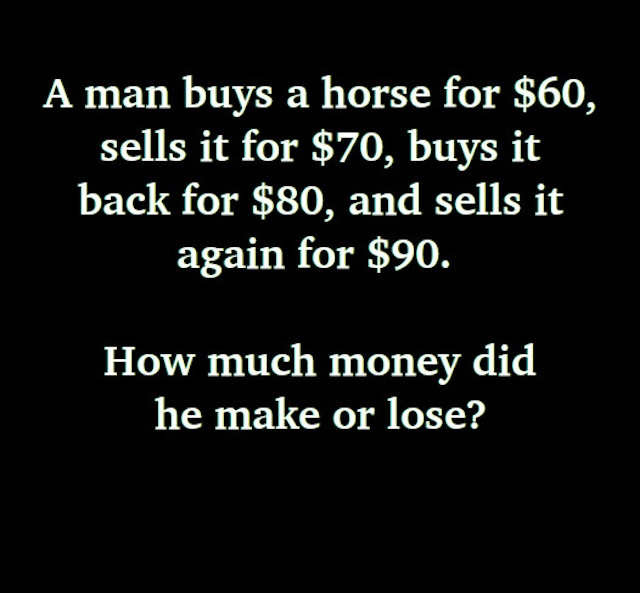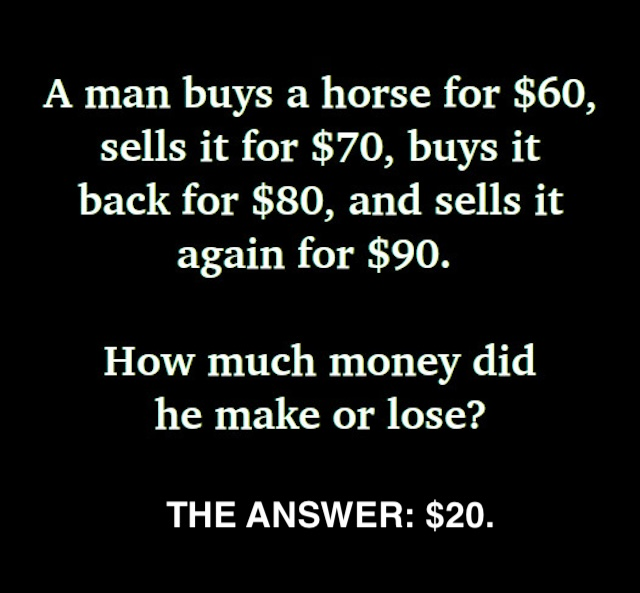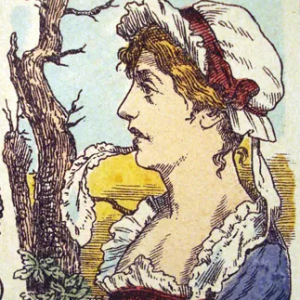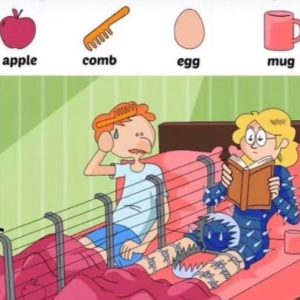Let’s play with your brain for a second.
A man buys a horse for $60.
Then he sells it for $70.
He buys it back for $80.
And sells it again for $90.
Here’s the burning question: How much profit did he actually make?
Sounds easy, right? But it’s one of those riddles that makes you stop mid-thought and go, “Wait, what?” Most people either overthink it or get lost in the back-and-forth of buying and selling. But don’t worry—we’re going to walk through it step-by-step and crack this puzzle wide open.

Why This Riddle Trips Everyone Up
At first glance, the problem seems a bit too straightforward. That’s what makes it so deceptive. The confusion usually comes from the two transactions happening back to back. People assume the whole situation is somehow more complicated than it is.
You might think you need to factor in ownership or maybe get tangled in what’s being sold and repurchased. But in truth, this riddle is all about pure numbers.
No tricks. No traps. Just math—if you slow down and follow the money.
Video: Only a Genius Can Solve These Riddles
The Common Mistake: Overthinking the Timeline
Here’s where most people mess up: they treat the sequence as one long, confusing story. They try to combine the transactions in some convoluted way, thinking the horse itself changes value or that there’s a hidden fee somewhere.
Spoiler: there’s not. What really matters here is how much cash changes hands, and how much of that ends up as profit. When you focus on that—and only that—the answer becomes crystal clear.
Let’s Break It Down: Step-by-Step
Time to dig into the numbers.
First Transaction
- The man buys the horse for $60.
- He sells it for $70.
- Profit = $70 – $60 = $10
Simple enough. At this point, he’s made $10 in profit and no longer owns the horse.
Second Transaction
- He buys back the horse for $80.
- Then sells it again for $90.
- Profit = $90 – $80 = $10
Again, another $10 profit on this second round.
Total Profit
- First deal: $10
- Second deal: $10
- Total = $10 + $10 = $20
That’s it. No tricks, no hidden losses. The man made $20 in total profit across the two transactions.

Still Confused? Think About It Like This…
If you’re still unsure, imagine this with something simpler—like a phone instead of a horse.
You buy a phone for $60 and sell it for $70. You’ve made $10.
Later, you buy the same phone back for $80 and sell it again for $90. Another $10.
Whether it’s a horse, phone, or even a loaf of bread, the principle stays the same. Every transaction stands alone. Profit is calculated on each sale individually.
Why This Riddle Is So Effective
Riddles like this catch people off guard because they challenge how we process step-by-step logic. We’re used to looking for twists. We expect complexity. So when a problem is actually simple, we second-guess ourselves.
And let’s be honest—we love a good mental challenge. It’s like our brain wants to work harder than it needs to.
That’s why this little horse scenario has taken off on social media and riddle forums. People love the aha! moment when they realize it’s all just basic arithmetic.
What This Riddle Teaches Us About Logic
There’s a bigger lesson tucked into this puzzle: don’t let complexity distract you from simplicity.
When problems seem confusing, slow down. Break things into parts. Don’t assume extra layers are hiding in the details. This kind of clear thinking is what helps you win—not just at riddles, but at real-life decisions too.
Remember, every big challenge is just a bunch of little steps stacked together.
Bonus Tip: Train Your Brain with Puzzles Like These
Video: 15 Riddles That Start Funny and End Smart
Riddles aren’t just fun party tricks—they sharpen your brain. They build critical thinking, attention to detail, and the ability to approach problems calmly.
Want to get better at solving them?
- Practice daily logic puzzles.
- Re-read the problem before jumping to conclusions.
- Think in terms of actions and outcomes, not just narrative.
You’ll be amazed how much more confident you’ll feel in everyday problem-solving once your brain gets used to this kind of exercise.
Conclusion: The $20 Profit Most People Miss
Let’s bring it back home.
A man bought a horse for $60 and sold it for $70.
Then he bought it again for $80 and sold it for $90.
He made $20 in total profit, $10 each time he sold.
That’s it. That’s the answer.
It’s not complicated. It’s just math. The trick? Not letting your brain turn a simple equation into a puzzle box. And that’s why this riddle is such a brilliant mental exercise—it forces you to see through the noise and trust the numbers.
So, next time someone tosses this “impossible” riddle your way, you’ll know the answer—and more importantly, you’ll know how to explain it.


